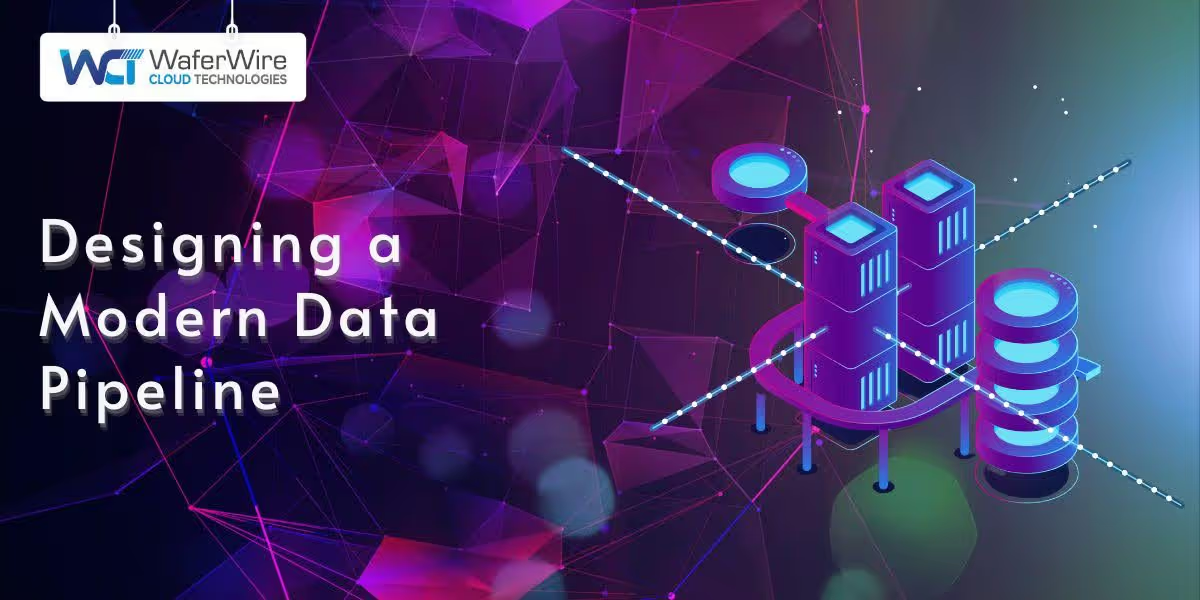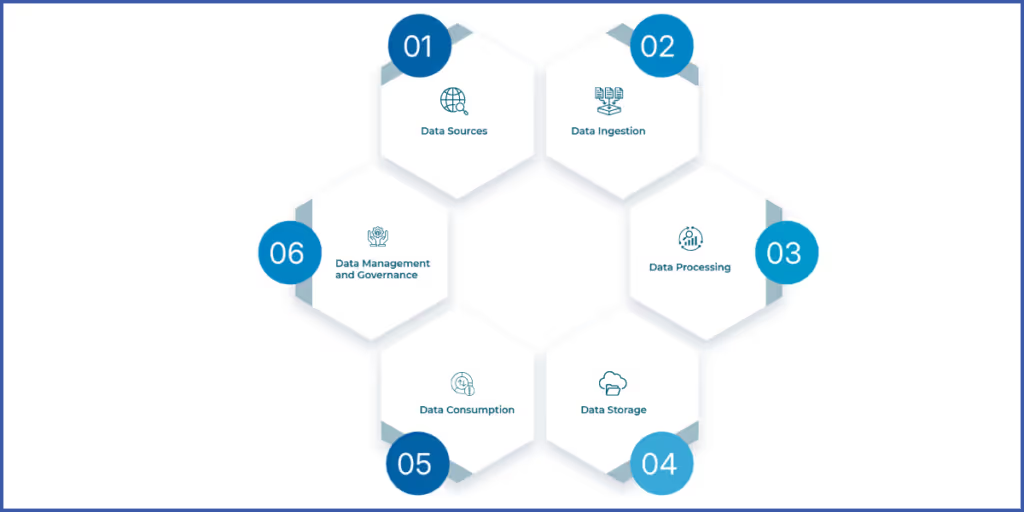

Organizations benefit significantly from building data pipelines that are efficient, scalable, and reliable, capable of managing the ever-growing influx of information. A modern data pipeline design is essential for unlocking the full potential of data, transforming raw information into valuable insights that drive informed decision-making and streamline business processes. By adopting robust, scalable pipelines, businesses can stay ahead of the competition and accelerate data-driven innovation.
This blog will discuss the key principles and best practices for building a modern data pipeline that is not only efficient but also scalable to meet future demands.
A modern data pipeline is a series of processes that automate the flow of data from one point to another, ensuring that data is collected, processed, stored, and consumed efficiently. The primary purpose of a data pipeline is to streamline data movement and transformation to enable timely, accurate decision-making.
Modern data pipelines are designed to handle vast and diverse data sources, ensuring the smooth and consistent flow of information. They integrate various data systems, automating tasks like data extraction, cleaning, and transformation, while maintaining high levels of reliability and performance.
Effective data pipelines ensure that data moves seamlessly from the source to the destination without interruptions. By managing the flow efficiently, businesses can ensure timely data processing, reducing delays in decision-making.
A modern data pipeline does more than just collect data; it processes and transforms raw information into meaningful insights. Data from various sources is integrated, cleaned, and enriched to be consumed by various stakeholders, whether for reporting, analytics, or machine learning purposes.
With this understanding of what a modern data pipeline entails, we can now delve into the key components that make up an efficient and scalable pipeline.

To build a reliable and scalable data pipeline, organizations must focus on the essential components that work in harmony. These components ensure data is properly captured, transformed, and made available for analysis, all while maintaining high levels of performance and compliance.
Now that we've covered the key components, let's discuss the building blocks required for making the data pipeline scalable to accommodate increasing data demands.
When designing a scalable data pipeline, it's essential to break down its core elements to ensure future growth is well-supported. Let's explore these building blocks one by one.
Scalability in data pipelines is achieved by focusing on specific foundational elements that enable systems to handle growing volumes and complexities effectively. Below are the critical building blocks for ensuring a scalable data pipeline:
1. Architecture Design
Choosing the right architecture tailored to your needs is foundational. A modular architecture, which allows individual components to scale independently, ensures adaptability and simplifies troubleshooting as your pipeline evolves.
2. Smart Data Management
Effective data management involves robust data quality checks, validation, and cleaning mechanisms. These practices reduce inconsistencies and maintain data integrity, which is vital as data volumes grow.
3. Parallel Processing
Utilizing parallel processing frameworks such as Apache Spark or Hadoop enables your pipeline to process large datasets efficiently. By dividing tasks across multiple processors, parallelism minimizes delays and optimizes resource utilization.
4. Optimized Data Processing
Latency reduction is key to scalability. Optimizing data transformations and workflows helps ensure smooth processing as datasets grow in size and complexity. This includes leveraging distributed processing and caching strategies.
5. Real-Time Processing
Modern businesses require real-time insights. A scalable pipeline prioritizes real-time data processing to handle live streams and enables quicker decision-making while adapting to changes instantly.
6. Fault Tolerance
A fault-tolerant architecture ensures uninterrupted operation, even in the event of hardware or software failures. Techniques such as data replication, retry mechanisms, and automated failovers are essential to building resilience.
7. Monitoring and Alerting
Comprehensive real-time monitoring and alerting systems are crucial for tracking pipeline health and performance. Tools like Prometheus or Grafana provide insights into potential bottlenecks and ensure proactive issue resolution.
8. Cost Optimization
Scalability must also be cost-effective. Designing pipelines with efficient resource allocation, leveraging pay-as-you-go cloud services, and reducing redundancies help manage costs while supporting growth.
9. Horizontal Scaling
Scaling horizontally by adding more nodes or servers allows your pipeline to handle increasing data loads without performance degradation. This design enables flexibility and ensures consistent throughput under high demand.
These building blocks form the foundation for creating a data pipeline that can effectively scale with your organization’s growing data demands. Let’s now look at best practices for ensuring these elements work together seamlessly to deliver high performance.
When designing a modern data pipeline, applying best practices can ensure that the system is not only scalable but also reliable and efficient. Following these practices helps avoid common pitfalls and guarantees that the pipeline can evolve with the business.
Scalability isn’t just about handling more data; it’s about ensuring that the system remains operational even when issues arise. Incorporating redundancy and failover mechanisms ensures that data continues to flow smoothly, even if one part of the system experiences issues.
A modular architecture makes it easier to scale different components of the pipeline independently. By breaking the pipeline into smaller, self-contained modules, organizations can focus on scaling only the parts that need it without overhauling the entire system.
Automation is key to reducing manual intervention and streamlining processes. By automating data cleaning, transformation, and movement, businesses can ensure that their pipeline operates efficiently at scale.
Cloud platforms provide the flexibility to scale infrastructure dynamically. With cloud-based solutions, organizations can quickly allocate resources as needed without having to invest in physical hardware.
Real-time monitoring and observability are essential for maintaining the health of a data pipeline. By continuously tracking key metrics and setting up alerts, businesses can quickly identify bottlenecks or failures and take corrective action.
After understanding these best practices, it's important to avoid common pitfalls that can hinder the performance and scalability of a data pipeline.
Building a modern data pipeline comes with its own set of challenges. By being mindful of common pitfalls, organizations can avoid costly mistakes that could affect the performance and scalability of their system.
One common mistake is overengineering the pipeline. While it’s important to build a system that can scale, unnecessary complexity can lead to maintenance issues and make troubleshooting difficult.
Without proper validation and quality checks, poor-quality data can compromise the entire pipeline. Ensuring data is clean and accurate from the start is crucial for maintaining the integrity of the pipeline.
Documentation is key to ensuring that team members understand how the pipeline works and can troubleshoot or expand it in the future. Without proper documentation, scaling or modifying the system becomes more challenging.
Let’s now take a look at the different types of data pipeline architectures and how they impact scalability.

There are different ways to architect a data pipeline, depending on the needs of the business. Each approach has its advantages and limitations, and selecting the right pattern is crucial for building a scalable pipeline.
Batch processing involves collecting data over a period of time and processing it in chunks. This approach is suitable for non-real-time use cases, such as generating daily reports or performing periodic analysis.
Real-time processing handles data immediately as it is ingested. This approach is critical for use cases that require up-to-the-minute insights, such as fraud detection or real-time analytics.
Hybrid processing combines both batch and real-time processing. It’s suitable for businesses that need both immediate insights and long-term data processing.
With the various data pipeline architectures in mind, the next step is to turn theory into practice. Let’s explore how to implement a pipeline that aligns with your business objectives and delivers measurable results.
Building a data pipeline from scratch requires a clear plan and understanding of the business objectives. Below are the key steps to follow :
1. Define Objectives and Requirements
Before starting, define the business goals you want to achieve with your data pipeline. Whether it’s improving data accessibility or enabling advanced analytics, having clear objectives will guide the entire design process.
2. Select Appropriate Tools and Technologies
Choosing the right tools for data ingestion, processing, and storage is critical to the pipeline’s success. Ensure that the selected technologies align with your business needs and are capable of scaling as your data grows.
3. Design and Architecture Setup
Next, design the architecture for your pipeline, considering scalability, fault tolerance, and performance. Ensure the architecture supports the different stages of data processing, from ingestion to consumption.
4. Develop and Implement Processing Logic
The processing logic should be designed to transform data into the required format for analysis. This includes data cleaning, enrichment, and aggregation.
5. Test and Validate Data Quality
Before going live, thoroughly test the pipeline to ensure that the data is accurate, reliable, and processed correctly. Continuous testing and validation will help maintain data quality over time.
When modernizing your data estate, leveraging cloud-based tools like Azure Data Factory can significantly enhance efficiency and scalability. Azure Data Factory enables businesses to build and manage data pipelines that integrate various data sources, automate workflows, and ensure seamless data movement across cloud and on-premise environments.
Additionally, Data Flow Gen2 within Azure Data Factory provides a powerful, no-code solution for transforming large volumes of data with advanced analytics and AI capabilities. By using these modern tools, businesses can streamline their data operations, improve processing speed, and enhance data quality—all while reducing manual intervention.
Modern data pipeline design is more than essential for today’s organizations looking to harness data for smarter business decisions. By implementing best practices, building scalable components, and avoiding common pitfalls, you can create a pipeline that meets current needs and scales seamlessly for future growth.
At WaferWire, we understand the importance of designing robust and scalable data pipelines tailored to your business needs. If you’re looking to modernize your data infrastructure and take full advantage of data analytics, we’re here to help. Contact WaferWire today to discuss how we can support your data pipeline journey and ensure your business remains ahead of the competition.

